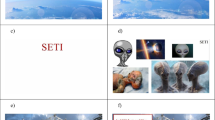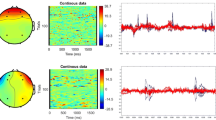Abstract
This study investigated the cognitive processes involved in learning information presented in multimedia and text format using electroencephalographic (EEG) measures. Thirty-eight students (19 gifted, and 19 average) learned material presented with text (text); text, sound, and picture (picture); and text, sound and video (video), while their EEG was recorded. Alpha power, which is inversely related to mental effort, was analyzed. For thetext presentation, the alpha power measures showed higher amplitudes (less mental activity) over the occipital and temporal lobes, and less alpha power (higher mental activity) over the frontal lobes. The results support the assumption that thevideo andpicture presentations induced visualization strategies, whereas thetext presentation mainly generated processes related to verbal processing. The results further showed that gifted students displayed less mental activity during all three formats of presentation. These differences were especially pronounced for thevideo format. No gender-related differences in EEG patterns related to the format of presentation were observed.
Similar content being viewed by others
References
Andreasen, N.C., O'Leary, D.S., Arndt, S., Cizadlo, T., Hurtig, R., Rezai, K., Watkins, G.L., Boles Ponto, L.L., & Hichwa, R.D. (1992). Short-term and long-term verbal memory: a positron emission tomography study.Proceedings of the National Academy of Sciences, 11, 5111–5115.
Blom, J.L. & Anneveldt, M. (1982). An electrode cap tested.Electroencephalography and Clinical Neuropsychology, 54, 591–594.
Bloom, B.S., & Krathwohl, D.R. (1956).Taxonomy of Educational Objectives: the classification of educational goals, by a committee of college and university examiners. Handbook I: Cognitive Domain. New York, Longmans, Green.
Bruer, J.T. (1997). Education and the brain: A bridge to far.Educational Researcher, 26, 4–16.
Butler, S.R., & Glass, A. (1976). EEG correlates of cerebral dominance. In A.H. Reisen, & R.F. Thompson (Eds.)Advances in psychology Vol. 3 (pp. 219–384). NY: John Wiley.
Clark, J.M., & Paivio, A. (1991). Dual coding theory and education.Educational Psychology Review, 3, 149–210.
Donchin, E., Kutas, M. & McCarthy, G. (1977). Electrocortical indices of hemispheric specialization. In S. Harnad, R.W. Doty, L. Goldstein, J. Jaynes and G. Krauthamer (Eds.)Lateralization in nervous system (pp. 339–384). New York: Academic Press.
Dunbar, K., & Sussman, D. (1995). Toward a Cognitive account of frontal lobe function: Simulating frontal lobe deficits in normal subjects.Annals of the New York Academy of Sciences, 769, 289–304.
Dunn, B., Dunn, D., Andrews, D., & Languis, M.L. (1992). Metacontrol: A cognitive model of brain functioning for psychophysiological study of complex learning.Educational Psychologist, 4, 455–471.
Fletcher, J. (1990).Effectiveness and cost of interactive videodisc instruction in defense training and education Washington, Institute for Defense Analyses. IDA Paper P-2372.
Glass, A. (1964). Mental arithmetic and blocking of the occipital alpha rhythm.Electroencephalography and Clinical Neurophysiology, 16, 595–603.
Glenberg, A.M., & Langston, W.E. (1992). Comprehension of illustrated text Pictures help to build mental models.Journal of Memory and Language, 31, 129–151.
Glenberg, A.M., & McDaniel, M.A. (1992). Mental models, pictures and text integration of spatial and verbal information.Memory & Cognition, 20, 458–460.
Gutierrez, S., & Corsi-Cabrera, M. (1988). EEG activity during performance of cognitive tasks demanding verbal and/or spatial processing.International Journal of Neuroscience, 62, 149–155.
Haier, R.J., Neuchterlein, K.H., Hazlett, E., Wu, J.C., Paek, J., Browning, H.L., & Buchsbaum, M.S. (1988). Cortical glucose metabolic rate correlates of abstract reasoning and attention studied with positron emission tomography.Intelligence, 12, 199–217.
Haier, R.J., Siegel, B., Tang, C., Abel, L., & Buchsbaum, M.S., (1992). Intelligence and changes in regional cerebral glucose metabolic rate following learning.Intelligence, 16, 415–426.
Jasper, H.H. (1958). The ten-twenty electrode system of the International Federation for Electroencephalography: Appendix to the report of the committee on methods of clinical examination in electroencephalography.The Journal of Electroencephalography and Clinical Neuropsychology, 10, 371–375.
Jaušovec, N. (1996). Differences in EEG alpha activity related to giftedness.Intelligence, 3, 159–173.
Jaušovec, N. (1997 a). Differences in EEG activity during the solution of closed and open problems.Creativity Research Journal, 4, 317–324.
Jaušovec, N. (1997 b) Differences in EEG alpha activity between gifted and non-identified individuals: Insights into problem solving.Gifted Child Quarterly, 1, 26–32.
Jaušovec, N. (1998). Are gifted individuals less chaotic thinkers?Personality and Individual Differences, 2, 253–267.
Kolb, B., & Whishaw, I.Q. (1996).Fundamentals of human neuropsychology (4th Edition). New York: W. H. Freeman and Company.
Kosslyn, S.M., Alpert, N.M., Thompson, W.L., Maljkovic, V., Weise, S.B., Chabris, C.F., Hamilton, S.E., Rauch, S.L., & Buonanno, F.S. (1993). Visual mental imagery activates topographically organized visual cortex: PET investigations.Journal of Cognitive Neuroscience, 5, 263–287.
Kosslyn, S.M., Thompson, W.L., Kim, I.J., & Alpert, N.M. (1995). Topographical representations of mental images in primary visual cortex.Nature, 378, 496–498.
Krause, W. (1992). Zur Messung geistiger Leistungen: Eine alte Idee und ein neuer Ansatz.Zeitschrift fur experimentele und angewandte Psychologie, 1, 114–128.
Kuhman, W., Lachnit, W., & Vaitl, D. (1985). The quantification of experimental load: Methodological and empirical issues. In A. Steptoe, H. Rueddel & H. Neus (Eds.),Clinical and methodological issues in cardiovascular psychophysiology (pp. 45–52). Berlin: Springer-Verlag.
Lookatch, R.P. (1995). The strange but true story of multimedia and the type I error.Technos, 2, 10–14.
Marsh, E.J., & Kumar, D.D. (1992). Hypermedia: A conceptual framework for science education and review of recent findings.Journal of Educational Multimedia and Hypermedia, 1, 25–37.
Mayer, R.E. (1997). Multimedia learning: Are we asking the right questions?Educational Psychologist, 1, 1–19.
Mayer, R.E., & Anderson, R.B. (1991). Animations need narrations: An experimental test of a dual-coding hypothesis.Journal of Educational Psychology, 83, 484–490.
Mayer, R.E., & Anderson, R.B. (1992). The instructive animation: Helping students build connections between words and pictures in multimedia learning.Journal of Educational Psychology, 84, 444–452.
Mayer, R.E., & Moreno, R. (1998). A split-attention effect in multimedia learning: Evidence for dual processing systems in memory.Journal of Educational Psychology, 90, 312–320.
Najjar, L.J. (1996). Multimedia information and learning.Journal of Educational Multimedia and Hypermedia, 2, 129–150.
Neubauer, V., Freudenthaler, H.H., & Pfurtscheller, G. (1995). Intelligence and spatiotemporal patterns of event-related desynchronization.Intelligence, 3, 249–266.
Nunez, P.L. (1995). Quantitative states of neocortex. In P.L. Nunez (Ed.)Neocortical dynamics and human EEG rhythms (pp. 3–67). NY: Oxford University Press.
Nyborg, H. (1994). The neuropsychology of sex-related differences in brain and specific abilities: Hormones, developmental dynamics and new paradigm. In P.A. Vernon (Ed.),The neuropsychology of individual differences (pp. 59–113). London: Academic Press INC.
O'Boyle, M.W., Benbow, C.P., & Alexander, J.E. (1995). Sex differences, hemispheric laterality, and associated brain activity in the intellectually gifted.Developmental Neuropsychology, 4, 415–443.
Paivio, A. (1991). Dual coding theory: Retrospect and current status.Canadian Journal of Psychology, 45, 255–287.
Petrides, M., Alivisatos, B., Meyer, E., Evans, A.C. (1993). Functional activation of the human frontal cortex during the performance of verbal working memory tasks.Proceedings of the National Academy of Sciences, 90, 878–882.
Pilgreen, K.L. (1995). Physiologic, medical, and cognitive correlates of electroencephalography. In P.L. Nunez (Ed.),Neocortical dynamics and human EEG rhythms (pp. 195–248) NY: Oxford University Press.
Rieber, L.P. (1995). A historical review of visualization in human cognition.Educational Technology Research and Development, 43(1), 45–56.
Schank, R.C., & Cleary, C. (1995).Engines for education. Hillsdale, NJ: LEA
Sharp, D.L.M., Bransford, J.D., Goldman, S.R., Risko, V.J., Kinzer, C.K., & Vye, N.J. (1995). Dynamic visual support for story comprehension and mental model building by young, at-risk children.Educational Technology Research and Development, 43(4), 25–42.
Simpson, M. (1994). Neuropsychological considerations related to interactive multimedia.Educational Technology Research and Development, 42(1), 75–81.
Author information
Authors and Affiliations
Rights and permissions
About this article
Cite this article
Gerě, I., Jaušcvec, N. Multimedia: Differences in cognitive processes observed with EEG. ETR&D 47, 5–14 (1999). https://doi.org/10.1007/BF02299630
Issue Date:
DOI: https://doi.org/10.1007/BF02299630




